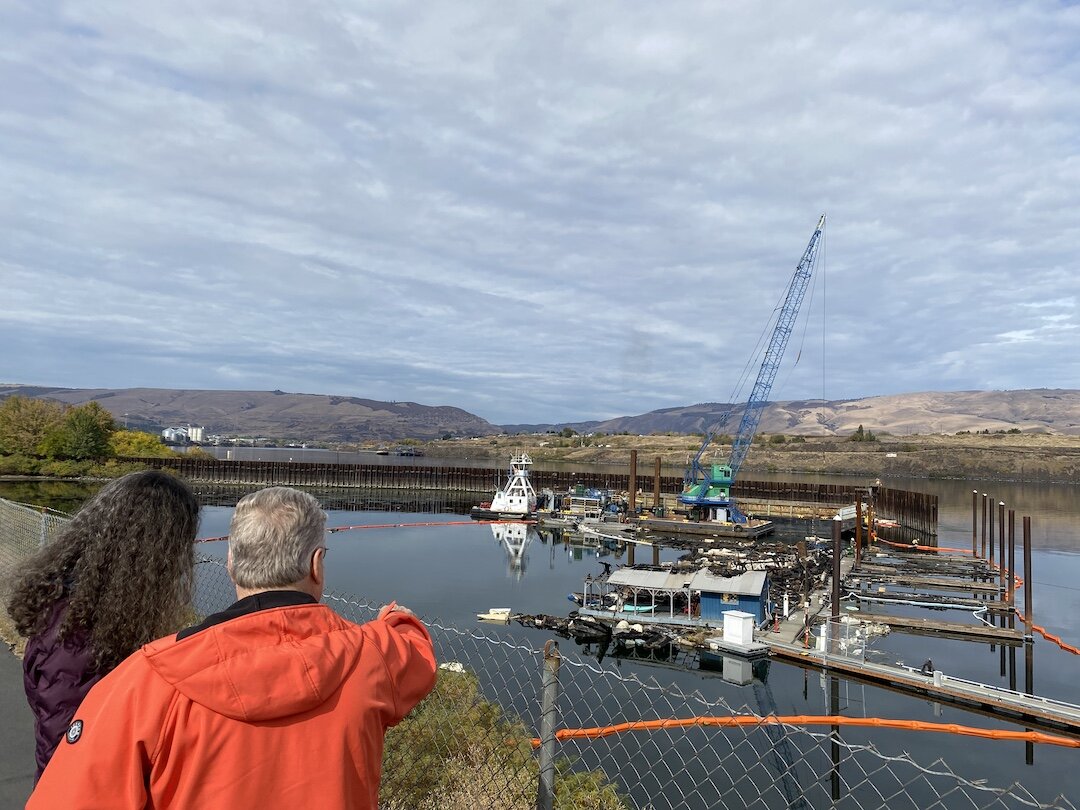TD Marina Cleanup in full swing; completion expected by Saturday, Oct. 16
The Port of The Dalles Executive Director Andrea Klaas and Robert Mester with Northwest Maritime Consultants go over the removal of wreckage at The Dalles Marina on Oct. 12 as a 100-ton crane, spoils barge, divers and crew work to clean up the area.
Andrea Klaas
By Tom Peterson
Divers are attaching cables to burned pontoons and houseboat wreckage on the river floor at The Dalles Marina, and a 100-ton crane is lifting it into a barge as the process to clean up the docking area got into full swing on Tuesday, Oct. 12.
“With the winter moving in, we needed to get this addressed,” said Port of The Dalles Executive Director Andrea Klaas.
The Port of The Dalles manages The Dalles Marina.
Crews are using cutting torches to remove damaged fingers of the B dock.
It appears that most of the entire docking area on the west end of the Marina will have to be replaced. Heat damage from the fire destroyed the polyethylene floats, burned much of the wooden structure and damaged the concrete.
The work is expected to be complete by Saturday, Oct. 16.
The Port of The Dalles has hired Robert Mester with Northwest Maritime Consultants to direct the operation to remove eight houseboats and two sunken boats destroyed in a fire on July 4th.
The Port is footing the initial bill to get Associated Underwater Services staged at the site at a cost of about $100,000.
And daily costs to operate can run about $14,000.
Several Insurance companies are still wrangling over payouts on the fire, and the Port decided to get the process of clean up moving before winter set in.
Director Klaas said it is expected the Port and boathouse and boat owners will have an equitable splitting of the entire clean-up bill in the future.
Bellingham Marine, which built the docks originally, has already completed an assessment of the dock damage.
On Tuesday, 11 workers removed the D-15 finger and pulled the wreckage from the water. Fingers 1, 3, 5, 7, 9, 11, 13,and 15 are all slated for removal.
On an up note, it appears that the 16-inch pilings driven into the river floor and holding the dock in place are still in good shape, Klaas said.
The crane, which is grounded by weights or ‘spuds” also uses a 12-foot clam bucket to remove debris from the river floor.
Mester said safety was the number one concern with three divers who were working in the dark muck. They are diving in 18-feet of water at the deepest point.
Both underwater cameras and radio communication are paramount in seeing and understanding how to safely remove the sunken boats and flotsam and jetsam, Mester said. Divers and crew are cleared from danger zones before the crane is cleared to operate.
“These guys earn their money,” he said.


